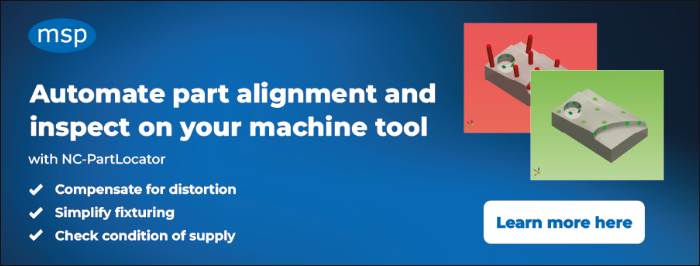Share this
How to create an accurate Best Fit alignment
by Hannah Brown on Jan 6, 2025 2:15:19 PM

In the manufacturing industry, there are various methods for accurately aligning parts before they are CNC machined. One of these alignment strategies is the Best Fit alignment method. This article explores what is involved when creating this type of alignment and the correct method for doing so to ensure parts are setup accurately and machined right-first-time.
What is a Best Fit alignment?
A Best Fit alignment strategy is the most suitable strategy for parts with no datum features to align from or parts that need to be finished to size. Best Fit alignments allow you to create datum features so they can be used to align, and then, inspect the part; replicating methods used in CMM inspection.
A Best Fit alignment strategy aims to create an optimal alignment that satisfies the geometric constraints or features of the part that need to be machined. The aim of this alignment method is to reduce the total deviation from the desired geometry, minimising errors that may result from the part’s size, position and variation of its features. For example, this method is particularly useful within Composites and Additive Manufacturing to compensate for distortion on parts or in the Castings and Forgings industry to compensate for under/oversize features due to poor material movement.
Why might you use a Best Fit alignment strategy?
- It allows your machining processes to cope with variable raw parts.
- It is a technique well-suited for parts that are over or under size or slightly distorted.
- Best Fit alignments do not require fixed points to align from, making it suitable for parts where there are no existing datum features.
- It means cheaper, generic fixturing can be used rather than expensive floating fixtures.
- Parts can be machined in their free state rather than forced into an over-constrained fixture.
- It allows for the alignment of high value parts that have complex features and curves and cannot be datum aligned accurately.
- The nominal machining program can be used for every part rather than creating adaptive processes with bespoke programs for every part.

MSP's software generates a 6-axis Best Fit alignment and automatically updates the controller for micron-accurate results.
The method for creating an accurate Best Fit alignment
When choosing the most accurate method for creating Best Fit alignments, MSP advocates for removing manual intervention as this is the only way to ensure true accuracy.
This has been made possible because of MSP’s NC-PartLocator software which uses the probe to measure the part at certain points to collect data. This data is used by NC-PartLocator to calculate what the Best Fit alignment of the part should be to ensure it will be machined to tolerance. This correct alignment is then uploaded to the controller to instruct the machine where to cut accurately. No manual intervention is required as communication happens automatically between the machine, controller and software.
A key feature of NC-PartLocator is the software calculates and applies a 6-axis Best Fit alignment to the part. This is unique to the software and makes it possible to achieve micron accuracy and a true compensation of where the part really is.
By creating a Best Fit alignment automatically in this way, the limitations often associated with this alignment strategy can be overcome:
- The automation means alignments can be adapted for a range of parts, tolerances, materials and production levels (e.g. one-off prototypes or serial production).
- Using this alignment strategy and software together can give you consistent quality through the industrialisation of a part.
- The software allows alignments to be created in-process on the CNC machine, eliminating the requirement for pre-process CMM inspection.
- The software also gives you an automated way to check alignments throughout the part machining process and recalculate them if necessary. As no manual input is required, the chance of cumulative errors building up is eliminated.
Start exploring Best Fit alignments today
If you are exploring alignment strategies and trying to find the most suitable one for aligning your complex parts, take time to consider Best Fit alignments. These alignments are mainly used for parts with no datum features to align from as an overall alignment is created based on various measured points across the part. But as this article has observed, that’s where the benefits only just begin, especially if using software like MSP’s to automatically calculate these Best Fit alignments. Not only do you overcome the problem of no datum features, but you also solve most (if not all!) of the issues commonly associated with manual alignment techniques. Start on the path to a more efficient and micron-accurate part setup process and find out just how productive your shopfloor could become.
If you deal with parts that have datum features, you might be better using a Datum alignment strategy instead.
Share this
- December 2025 (1)
- August 2025 (1)
- June 2025 (2)
- April 2025 (1)
- March 2025 (2)
- January 2025 (1)
- November 2024 (1)
- April 2023 (2)
- December 2022 (2)
- July 2022 (1)
- May 2022 (4)
- November 2021 (1)
- October 2021 (1)
- September 2021 (2)
- January 2021 (1)
- December 2020 (1)
- December 2018 (1)
- August 2018 (1)
- August 2017 (1)





